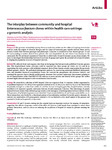2022-01-18Zeitschriftenartikel
The interplay between community and hospital Enterococcus faecium clones within health-care settings: a genomic analysis
van Hal, Sebastiaan J.
Willem, Rob J. L.
Gouliour, Theodore
Ballard, Susan A.
Coqu, Teresa M.
Hammerum, Anette M.
Hegstad, Kristin
Pinholt, Mette
Howden, Benjamin P.
Malhotra-Kumar, Surbhi
Werner, Guido
Yanagihara, Katsunori
Earl, Ashlee M.
Raven, Katherine E.
Corander, Jukka
Bowden, Rory
the Enterococcal Study Group
Background:
The genomic relationships among Enterococcus faecium isolates are the subject of ongoing research that seeks to clarify the origins of observed lineages and the extent of horizontal gene transfer between them, and to robustly identify links between genotypes and phenotypes. E faecium is considered to form distinct groups—A and B—corresponding to isolates derived from patients who were hospitalised (A) and isolates from humans in the community (B). The additional separation of A into the so-called clades A1 and A2 remains an area of uncertainty. We aimed to investigate the relationships between A1 and non-A1 groups and explore the potential role of non-A1 isolates in shaping the population structure of hospital E faecium.
Methods:
We collected short-read sequence data from invited groups that had previously published E faecium genome data. This hospital-based isolate collection could be separated into three groups (or clades, A1, A2, and B) by augmenting the study genomes with published sequences derived from human samples representing the previously defined genomic clusters. We performed phylogenetic analyses, by constructing maximum-likelihood phylogenetic trees, and identified historical recombination events. We assessed the pan-genome, did resistome analysis, and examined the genomic data to identify mobile genetic elements. Each genome underwent chromosome painting by use of ChromoPainter within FineSTRUCTURE software to assess ancestry and identify hybrid groups. We further assessed highly admixed regions to infer recombination directionality.
Findings:
We assembled a collection of 1095 hospital E faecium sequences from 34 countries, further augmented by 33 published sequences. 997 (88%) of 1128 genomes clustered as A1, 92 (8%) as A2, and 39 (4%) as B. We showed that A1 probably emerged as a clone from within A2 and that, because of ongoing gene flow, hospital isolates currently identified as A2 represent a genetic continuum between A1 and community E faecium. This interchange of genetic material between isolates from different groups results in the emergence of hybrid genomes between clusters. Of the 1128 genomes, 49 (4%) hybrid genomes were identified: 33 previously labelled as A2 and 16 previously labelled as A1. These interactions were fuelled by a directional pattern of recombination mediated by mobile genetic elements. By contrast, the contribution of B group genetic material to A1 was limited to a few small regions of the genome and appeared to be driven by genomic sweep events.
Interpretation:
A2 and B isolates coming into the hospital form an important reservoir for ongoing A1 adaptation, suggesting that effective long-term control of the effect of E faecium could benefit from strategies to reduce these genomic interactions, such as a focus on reducing the acquisition of hospital A1 strains by patients entering the hospital.
Funding:
Wellcome Trust.
Dateien zu dieser Publikation

